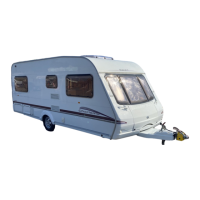Fitted Equipment
Never put bottles or cans of fizzy drinks in
the frozen food storage compartment as
they may burst when freezing.
Most kinds of frozen food can be stored in
the frozen food compartment for about a
month. This period of time may vary,
however, it is important to follow the
instructions on the individual packages.
ICE MAKING
It is practical to make ice during the night -
when the refrigerator is less demanded and
the cooling unit has more reserves. Fill the
ice tray to just below the brim with drinking
water and place it on the freezer shelf.
It is possible to make ice faster by turning
the control knob temporarily to its highest
value but do not forget to turn it back to its
regular setting afterwards as the refrigerator
might otherwise become too cold.
DEFROSTING
Frost will gradually accumulate on the
refrigerator surfaces. It must not be allowed
to grow too thick as it acts as an insulator
and adversely affects refrigerator
performance. Check the formation of frost
regularly every week and when it gets about
3mm thick, defrost the refrigerator.
To defrost the refrigerator, turn it off and
remove the ice trays and all food items.
Leave the cabinet and freezer doors open.
Do not try to accelerate defrosting by using
any kind of heating appliance as this might
damage the plastic surfaces of the
refrigerator. Neither should any sharp
objects be used to scrape off the ice.
The defrost water runs from a collector
channel to a receptacle at the rear of the
refrigerator where it normally evaporates.
Heavy frost build up on the freezer plate and
the cooling fins, and a lot of defrost water:
Move the plastic drain tube into a watertight
bucket or container. (Access through the
lower ventilation grill on the outside of the
vehicle). As the frost melts, the water will
flow into the container. Replace the drain
tube to its original position after defrosting.
Defrost water in the freezer compartment
should be mopped up with a cloth.
When the ice has melted, wipe the
refrigerator dry and restart it. Place the food
items back inside but wait until the
refrigerator is cold before making ice cubes.
CLEANING THE REFRIGERATOR
Clean the inside of the refrigerator regularly
to keep it fresh and hygienic.
Soak a cloth in a solution consisting of a
teaspoon of bicarbonate of soda to half a
litre of warm water. Wring out the cloth and
use it to clean the interior of the refrigerator
and its fittings.
Never use detergents, scouring powder,
strongly scented products or wax polish to
clean the interior of the refrigerator as they
may damage the surfaces and leave a strong
odour.
The exterior of the refrigerator should be
wiped clean now and then, using a damp
cloth and a small quantity of detergent, but
not the door gasket which should only be
cleaned with soap and water and then
thoroughly dried.
The cooling unit behind the refrigerator
should be cleaned with a brush from time to
time, but make sure that the refrigerator is
switched off when doing this.
TURNING OFF THE REFRIGERATOR
If the refrigerator is not to be used for some
time:
1. Turn all controls "OFF".
2. Shut off any on-board valve in the gas
line to the refrigerator.
3. Empty the refrigerator. Defrost and clean
it as described earlier. Leave the doors of
the refrigerator and frozen food
compartment ajar.
4. When the vehicle is laid up for a long
period of time (e.g. during the winter
months), we suggest fitting the winter
covers on to the grills.
70

